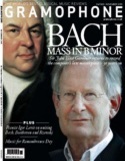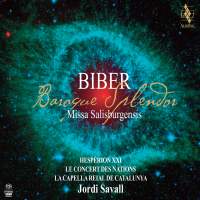Texte paru dans: / Appeared in: |
|
|
Outil de traduction (Très approximatif) |
|
|
Reviewer: Lindsay Kemp
That Biber’s massive 54-part Missa Salisburgensis of 1682 was for a long time carelessly attributed to Orazio Benevoli and dated 1628 shows how wrong scholars can sometimes get things without anybody noticing, and probably explains the lack of interest in it until its re-attribution to Biber in the 1970s. Since then, however, things have looked up for it (as they have for Biber), and this is at least its fourth recording, its rivals including fine earlier ones conducted by Paul McCreesh (A/98) and Ton Koopman (11/99). It also follows on from Jordi Savall’s own recordings of Biber’s A major Requiem and Missa Bruxellensis, reflecting increased general appreciation of the great 17th-century violinist as a composer of sacred vocal music.
Those earlier recordings of Savall’s were made in Salzburg Cathedral, the cavernous acoustic for which they were originally intended by Biber in his capacity as Kapellmeister to the Archbishop’s court. The Missa Salisburgensis was likewise written for the Cathedral – almost certainly for the 1100th anniversary of the founding of the Salzburg archbishopric – but this time Savall has recorded it in the chapel of Cardona Castle in Catalonia, a similarly atmospheric space but also a more manageable one. This is an important advantage, for if your idea of Biber’s sacred music is primarily of dialogues of choral block-harmonies rooted in the trumpet-and-drum keys, you may be surprised by some of the subtleties present in this work. Yes, it is a giant – voices, strings, recorders, oboes, dulcians, cornets, strings, trombones, drums and organ deployed in eight separate choirs – but surely few could find the lyrical tenderness of the ‘Christe eleison’, the plangently mounting lines of the ‘Crucifixus’ or the playful and intimate ‘Osanna’ wanting in delicacy. Biber manages these expressive contours with great skill and flexibility, too, making this perhaps his richest and most varied choral work.
Savall marshals the music with a keen sensibility to momentum, balance and colour. Koopman’s account, made in Salzburg Cathedral, achieves a surprising brassy punch and lucidity, while McCreesh in Romsey Abbey is more massive, if occasionally a touch thunderously overbearing. Not that this is a piece about understatement; but, compared to these, Savall’s more organically natural acoustic makes for an easier overall listen while losing only a little in forthright splendour. His coupling – trumpet fanfares by Riedl, Biber’s motet Plaudite tympana and the earlier Sonata Sancti Polycarpi for nine trumpets, plus an oddly incongruous and cool Battalia imported from an earlier recording, seems a trifle unconsidered compared to the others’ systems of interpolated sonatas. Still, the Mass is the thing here, and it certainly makes its awesome point.
|
|
|
|
|
|
Cliquez l'un ou l'autre
bouton pour découvrir bien d'autres critiques de CD |
|




